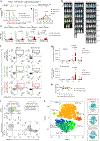A CAR enhancer increases the activity and persistence of CAR T cells
- PMID: 39079964
- PMCID: PMC11779983
- DOI: 10.1038/s41587-024-02339-4
A CAR enhancer increases the activity and persistence of CAR T cells
Abstract
Although chimeric antigen receptor (CAR) T cell therapies have demonstrated promising clinical outcomes, durable remissions remain limited. To extend the efficacy of CAR T cells, we develop a CAR enhancer (CAR-E), comprising a CAR T cell antigen fused to an immunomodulatory molecule. Here we demonstrate this strategy using B cell maturation antigen (BCMA) CAR T cells for the treatment of multiple myeloma, with a CAR-E consisting of the BCMA fused to a low-affinity interleukin 2 (IL-2). This selectively induces IL-2 signaling in CAR T cells upon antigen-CAR binding, enhancing T cell activation and antitumor activity while reducing IL-2-associated toxicities. We show that the BCMA CAR-E selectively binds CAR T cells and increases CAR T cell proliferation, clearance of tumor cells and development of memory CAR T cells. The memory cells retain the ability to re-expand upon restimulation, effectively controlling tumor growth upon rechallenge. Mechanistic studies reveal the involvement of both CAR and IL-2 receptor endodomains in the CAR-E mechanism of action. The CAR-E approach avoids the need for specific engineering and enables CAR T cell therapy with lower cell doses.
© 2024. The Author(s), under exclusive licence to Springer Nature America, Inc.
Conflict of interest statement
Competing interests: T.R. and M.R. are inventors on a related patent application. M.R. is the scientific founder of Koi Biotherapeutics. C.A.J. serves as a consultant for Kite/Gilead, Novartis, BMS, Sana, Synthekine, Janssen, Miltenyi, Caribou, Galapagos, ADC Therapeutics, AstraZeneca and Abbvie, and receives research funding from Kite/Gilead. O.N. receives research support from Takeda and Janssen, participates on advisory boards for Bristol Myers Squibb, Janssen, Sanofi, Takeda and GPCR Therapeutics, and receives honoraria from Pfizer. The other authors declare no competing interests.
Figures






References
MeSH terms
Substances
Grants and funding
LinkOut - more resources
Full Text Sources
Medical
Research Materials

